
loading

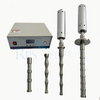



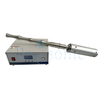

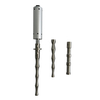

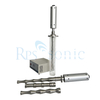

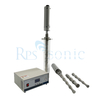
| Availability: | |
|---|---|
| Quantity: | |
RPS-SONO20
RPS-SONIC
| Place of Origin | China |
|---|---|
| Brand Name | RPS-SONIC |
| Certification | CE |
| Model Number | RPS-20-2000 |
| Minimum Order Quantity | 1set |
| Price | negotiation |
| Packaging Details | Foam And Wood Box |
| Delivery Time | 3days |
| Payment Terms | T/T, Western Union, MoneyGram |
| Supply Ability | 200 sets per month |
Powerful Ultrasound Processor For Liquid Ttreatments Homogenization
Description
Ultrasonic sewage treatment equipment is a kind of equipment that uses ultrasonic technology to treat sewage. It mainly uses the cavitation effect, shear force and thermal effect generated by ultrasound in water to help destroy harmful substances in sewage, decompose organic pollutants, and promote the separation and degradation of sediments and suspended matter in sewage, thereby improving sewage treatment efficiency. Ultrasonic sewage treatment equipment has the advantages of high efficiency, energy saving, and environmental protection. It is widely used in industrial wastewater treatment, urban sewage treatment, drinking water purification, environmental remediation and other fields.
Principles of ultrasonic sewage treatment
1. Cavitation effect: The high-frequency vibration generated by the ultrasonic transducer is transmitted through the liquid, causing the periodic expansion and collapse of tiny bubbles in the liquid. This phenomenon is called the cavitation effect. The collapse of cavitation bubbles releases huge energy and local high temperature, generating strong shear force and liquid flow shock waves. These energies can effectively decompose pollutants such as organic matter, grease, cells, etc. in the water.
2. Destroy the structure of pollutants: The high-energy shock waves and high-temperature effects generated by ultrasound can destroy the molecular structure of pollutants in the water, causing them to decompose or crack. For example, organic matter such as grease, dyes, pesticides, etc. will undergo chemical reactions or physical changes under the action of ultrasound, making them easier to decompose or remove.
3. Enhance flocculation: Under the action of ultrasound, suspended matter, colloidal particles, etc. in the water will produce strong impact and aggregation, enhancing the interaction between particles, thereby prompting them to aggregate to form larger flocs, which are convenient for subsequent sedimentation or filtration removal.
4. Promote chemical reactions: Ultrasonic waves can accelerate chemical reactions in water by providing local high temperature, high pressure and energy. For example, in the sewage treatment process, ultrasound can promote the oxidation and reduction reactions of chlorides and organic matter, increase the reaction rate, and enhance the sewage treatment effect.
5. Decomposition of toxic substances: Ultrasonic waves can decompose some toxic and harmful substances in water, such as organic solvents, pesticide residues, etc., thereby reducing the degree of water pollution. Ultrasonic treatment can also reduce the activity of certain microorganisms and inhibit their growth.
Specifications
| Model | RPS20-1000 | RPS20-1500 | RPS20-2000 | RPS20-3000 |
| Frequency | 20±1 KHz | 20±1 KHz | 20±1 KHz | 20±1 KHz |
| Power | 1000 W | 1500 W | 2000 W | 3000 W |
| Voltage | 220±10% V | 220±10% V | 220±10% V | 220±10% V |
| Temperature | 300 ℃ | 300 ℃ | 300 ℃ | 300 ℃ |
| Pressure | 35 MPa | 35 MPa | 35 MPa | 35 MPa |
| Intensity of sound | >20 W/cm² | >30 W/cm² | >40 W/cm² | >60 W/cm² |
| Max Capacity | > 10 L/Min | > 15 L/Min | > 20 L/Min | > 30 L/Min |
| Material Of Tip Head | Titanium Alloy | Titanium Alloy | Titanium Alloy | Titanium Alloy |
| Horn type | Spiral type/ Trumpet type/Cylindrical Optional.Please inquiry technical for horn suggestion , different application need different horn. | |||
Powerful Ultrasound Processor For Liquid Ttreatments Homogenization
Description
Ultrasonic sewage treatment equipment is a kind of equipment that uses ultrasonic technology to treat sewage. It mainly uses the cavitation effect, shear force and thermal effect generated by ultrasound in water to help destroy harmful substances in sewage, decompose organic pollutants, and promote the separation and degradation of sediments and suspended matter in sewage, thereby improving sewage treatment efficiency. Ultrasonic sewage treatment equipment has the advantages of high efficiency, energy saving, and environmental protection. It is widely used in industrial wastewater treatment, urban sewage treatment, drinking water purification, environmental remediation and other fields.
Principles of ultrasonic sewage treatment
1. Cavitation effect: The high-frequency vibration generated by the ultrasonic transducer is transmitted through the liquid, causing the periodic expansion and collapse of tiny bubbles in the liquid. This phenomenon is called the cavitation effect. The collapse of cavitation bubbles releases huge energy and local high temperature, generating strong shear force and liquid flow shock waves. These energies can effectively decompose pollutants such as organic matter, grease, cells, etc. in the water.
2. Destroy the structure of pollutants: The high-energy shock waves and high-temperature effects generated by ultrasound can destroy the molecular structure of pollutants in the water, causing them to decompose or crack. For example, organic matter such as grease, dyes, pesticides, etc. will undergo chemical reactions or physical changes under the action of ultrasound, making them easier to decompose or remove.
3. Enhance flocculation: Under the action of ultrasound, suspended matter, colloidal particles, etc. in the water will produce strong impact and aggregation, enhancing the interaction between particles, thereby prompting them to aggregate to form larger flocs, which are convenient for subsequent sedimentation or filtration removal.
4. Promote chemical reactions: Ultrasonic waves can accelerate chemical reactions in water by providing local high temperature, high pressure and energy. For example, in the sewage treatment process, ultrasound can promote the oxidation and reduction reactions of chlorides and organic matter, increase the reaction rate, and enhance the sewage treatment effect.
5. Decomposition of toxic substances: Ultrasonic waves can decompose some toxic and harmful substances in water, such as organic solvents, pesticide residues, etc., thereby reducing the degree of water pollution. Ultrasonic treatment can also reduce the activity of certain microorganisms and inhibit their growth.
Specifications
| Model | RPS20-1000 | RPS20-1500 | RPS20-2000 | RPS20-3000 |
| Frequency | 20±1 KHz | 20±1 KHz | 20±1 KHz | 20±1 KHz |
| Power | 1000 W | 1500 W | 2000 W | 3000 W |
| Voltage | 220±10% V | 220±10% V | 220±10% V | 220±10% V |
| Temperature | 300 ℃ | 300 ℃ | 300 ℃ | 300 ℃ |
| Pressure | 35 MPa | 35 MPa | 35 MPa | 35 MPa |
| Intensity of sound | >20 W/cm² | >30 W/cm² | >40 W/cm² | >60 W/cm² |
| Max Capacity | > 10 L/Min | > 15 L/Min | > 20 L/Min | > 30 L/Min |
| Material Of Tip Head | Titanium Alloy | Titanium Alloy | Titanium Alloy | Titanium Alloy |
| Horn type | Spiral type/ Trumpet type/Cylindrical Optional.Please inquiry technical for horn suggestion , different application need different horn. | |||








Ultrasonic Welding Equipment Ultrasonic Welding Transducer Ultrasonic Welding Converter Ultrasonic Liquid Processor Ultrasonic Cutting Equipment Ultrasonic Spray Nozzles Ultrasonic Power Supply Ultrasonic Soldering Equipment Ultrasonic Welding Horn Ultrasonic Assisted Machining Ultrasonic Testing Equipment